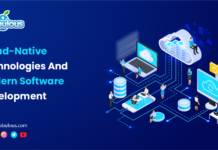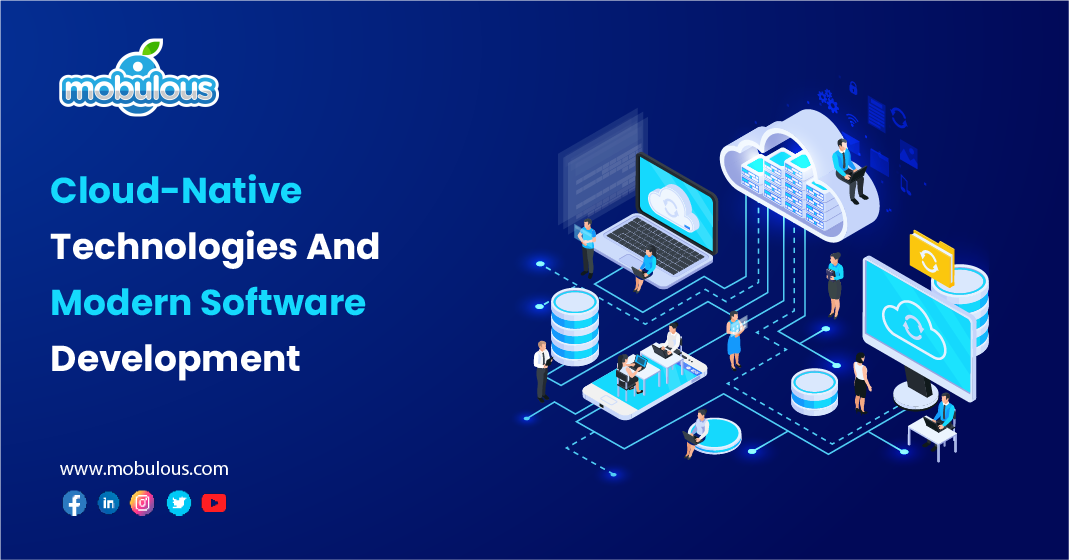Cloud-Native Technologies And Modern Software Development
Cloud-native solutions are a shift in software architecture, adopting containers, dynamic orchestration, and microservices to develop and execute highly scalable applications in contemporary cloud infrastructures.
The solutions enable organizations to build manageable, fault-tolerant, and observable systems while capitalizing on cloud computing advantages. Contemporary software development has matured to meet the needs of digital transformation that provides frictionless scaling, automated deployment, and consistent development environments on all platforms.
By embracing aggressive practices such as infrastructure as a code (IaaC), DevOps, and continuous integration/deployment (CI/CD), companies can accelerate innovation with reliability. The practice enables companies to provide value to customers promptly in response to changing markets.
For Query:- Seek Guidance From a Mobile App Development Company!
What Does “Cloud-Native” Mean?
Cloud-native is a way of developing and operating apps that take full advantage of cloud computing. Instead of merely transferring traditional apps to the cloud, cloud-native apps are built specifically for the cloud.
These applications are developed to adopt characteristics such as scalability, elasticity, and resilience from the very beginning. These applications are typically developed by taking advantage of microservices architecture, managed by Agile DevOps practices, and packaged in containers.
This approach enables rapid deployment, smooth updates, and efficient resource use without compromising high performance and availability.
For Query:- Seek Help From a Cloud Hosting Service Company!
What is Modern Software Development?
Contemporary software development is a comprehensive methodology that focuses on automation, agility, and continuous delivery. It combines practices such as the Agile method, DevOps, and collaborative development to create highly scalable, efficient, and maintainable software solutions.
The methodology focuses on fast iteration, continuous feedback loops, and rapid deployment. It employs containerization, automation tools, and cloud services in an effort to streamline the development processes.
Contemporary software development also focuses on integrating security right from the beginning (DevSecOps), data-driven decision-making, and cross-functional team collaboration to provide high-quality software that meets the changing business needs seamlessly and without hassle.
Also Read:- How Much Does Software Development Cost in 2025!
What Are Cloud-Native Technologies?
Cloud-native technologies are robust tools, services, and platforms that are specifically designed to create, deploy, and handle modern apps in cloud environments. They allow organizations in order to create resilient and highly scalable apps that can run anywhere while maximizing cloud computing benefits.
The examples of the best cloud-native technologies are given below:
- Containers (Docker, containers)
- Container Orchestration (Kubernetes, Amazon ECS)
- Service Mesh (Istio, Linkerd)
- Serverless Platforms (AWS Lambda, Azure Functions)
- Cloud Databases (MongoDB Atlas, Amazon DynamoDB)
- CI/CD Tools (Jenkins, GitLab CI)
- Monitoring Tools (Prometheus, Grafana)
- API Gateways (Kong, Ambassador)
Also Read:- The Impact of Cloud Computing on Mobile App Development Companies!
How Cloud Native Technologies Help in Modern Software Development?
Cloud-native technologies have transformed software development by offering strong tools and platforms that allow organizations to develop, manage, and deploy apps more efficiently. Let’s learn how they contribute to modern software development:
1. Accelerated Development and Deployment
Cloud-native software development teams can develop faster and better by utilizing containerization and microservices architecture.
Containers offer uniform environments across development, testing, and production phases that eliminate “it works on my machine” problems.
CI/CD pipelines that are automated facilitate fast deployment and testing, while infrastructure as code guarantees consistent environment configuration and setup.
2. Enhanced Scalability and Resource Optimization
Cloud-native technologies enable automatic scaling that depends on demand and ensure apps can handle diverse workloads effectively.
Container orchestration platforms like Kubernetes handle resource allocation dynamically, optimizing infrastructure costs.
This scalability enables businesses to maintain performance during peak times while optimizing resource usage at the time of quieter periods.
3. Improved Reliability and Resilience
Cloud-native applications today are designed with inherent redundancy and fault tolerance.
Container orchestration and service mesh offer load balancing, failover, and self-healing features.
This typically provides high availability and low downtime and distributed systems architecture prevents single points of failure.
4. Better Monitoring and Maintenance
Cloud-native technologies provide extensive monitoring, observability, and logging tools that offer deep insights into application health and performance.
Modern software development teams can track metrics, enforce fixes, and detect issues early quickly. Automated alerting and monitoring systems help maintain service quality and allow for proactive problem resolution.
5. Increased Innovation and Flexibility
The cloud-native software development modularity allows teams to innovate at an accelerated pace by replacing or upgrading a single component without impacting the system as a whole.
Microservices architecture enables teams to work separately on different devices and platforms, and containerization supports effortless experimentation using new technologies and rapid rollback if necessary.
Key Principles of Cloud-Native Computing
Cloud-native computing is a paradigm shift in the way applications are developed and deployed. These concepts are the pillars upon which today’s cloud applications are built that allow companies to develop scalable, efficient, and robust software systems capable of leveraging the full potential of cloud infrastructure while ensuring reliability and flexibility.
1. Microservices Architecture
Microservices decompose apps into tiny and autonomous services that interact via clearly defined APIs. This modularity allows software development teams to develop, deploy, and scale services separately.
Each service concentrates on a particular business function that makes the system simpler to comprehend, change, and maintain and encourages team independence.
2. Containerization
Containerization bundles apps and their dependencies into isolated and portable units, which behave consistently across different environments.
Containers offer efficient and lightweight use of resources and fast deployment capability that allows apps to run reliably when transferred between computing environments.
3. Automation
Automation streamlines development, testing, and deployment activities via CI/CD pipelines, automated tests, and infrastructure as a code (IaaC).
This reduces human intervention, minimizes errors, and speeds up delivery cycles. Automated activities provide consistency, repeatability, and reliability in application deployment and maintenance.
4. Scalability
Cloud-native applications are built especially to manage heterogeneous workloads using auto-scaling. They scale horizontally by increasing or decreasing instances based on need, and vertically by modifying resource allocation.
Such elasticity provides for resource utilization and best performance with cost-effectiveness.
5. Resilience
Resilience allows apps to continue being accessible despite failures through the design of distributed systems, self-healing, and fault-tolerance features.
Failures are managed by systems designed specifically to operate gracefully, sustain service availability, and recover automatically from faults by means of redundancy and intelligent load balancing.
Core Components of Cloud-Native Technologies
Important building blocks such as orchestration platforms, containers, serverless computing, microservices, and DevOps tools work together to allow cloud-native app development and deployment. Below are the core components of cloud-native technologies.
1. Containers: The Foundation of Cloud-Native Development
Containers encapsulate apps and dependencies in portable and lightweight packages. They provide consistency across environments, frequent deployment capabilities, and effective resource utilization.
Docker and container have become industry standards that enable apps to run reliably anywhere while reducing overhead and maximizing portability.
2. Microservices Architecture: Breaking Down Monoliths
Microservice breaks applications into independent, loosely coupled services that are in charge of defined business capabilities and interact using APIs.
The style of architecture features independent scaling, deployment, and maintenance of the services with the empowerment of teams along with technology heterogeneity in today’s software systems.
3. Kubernetes and Container Orchestration
Kubernetes handles containerized apps at a scale that handles deployment, scaling, and operations automatically.
It provides service discovery, self-healing capabilities, and load balancing. As the de facto standard for container orchestration, Kubernetes ensures effective application reliability and resource utilization.
4. Serverless Computing: Redefining Resource Management
Serverless platforms abstract infrastructure management, enabling software developers to focus solely on code. Functions run in response to events, with automatic pay-per-use pricing and scaling.
This model eradicates infrastructure management overhead and enables rapid software development of event-driven applications.
5. DevOps and CI/CD Pipelines
DevOps practices and CI/CD pipelines automate the software delivery process from code commit to production deployment.
They enable quick and trusted releases through automated testing, integration, and deployment processes. This methodology accelerates development cycles while maintaining reliability and quality.
For Query:- Seek Guidance From DevOps App Development Company!
Advantages of Modern Software Development
Modern software development brings transformative benefits to firms and enterprises through enhanced processes, approaches, and tools. These benefits enable firms to deliver better software quickly while maintaining innovation and quality. Below are the key advantages of modern software development:
1. Faster Time to Market
Modern software development practices such as Agile approaches and automated pipelines substantially reduce the development cycles.
Teams can deliver features incrementally, seek feedback quickly, and adjust to market changes quickly. This speed-to-market advantage helps firms stay competitive and respond to customer needs more efficiently.
2. Enhanced Quality and Reliability
Automated testing, uniform development environments, and continuous integration provide guaranteed quality at all stages of software development.
Daily code reviews, security features as part of the design, and automated quality inspections detect and rectify problems at an early stage, resulting in more stable and highly reliable software products.
3. Improved Collaboration and Communication
Cross-functional teams, collaboration platforms, and shared tools facilitate improved communication and knowledge sharing.
DevOps practices eliminate silos between operations and development teams, and version control and documentation tools provide traceability and transparency during the development process.
4. Greater Flexibility and Adaptability
New software development practices allow for rapid pivoting and adjustment based on feedback or changing market needs.
Cloud platforms, modular architectures, and containerization allow teams to try out the newest technologies and evolve their solutions without significant disruption.
5. Cost-Effective Development
Automated processes, effective modern software development practices, and cloud resources reduce operational costs.
Pay-as-you-go cloud services, optimized resource utilization, and automated scaling help organizations handle expenses while maintaining high performance.
6. Better User Experience
Continuous feedback loops, the ability for quick iteration, and user-centric design practices make it possible for software development teams to produce software that meets user needs without interruption.
Frequent updates and improvements based on user feedback make the software useful and relevant.
Benefits of Using Cloud-Native Technologies in Modern Software Development
Cloud-native technologies revolutionize contemporary software development through better scalability, lowered costs, increased deployment speed, and better resilience.
Cloud-native technologies make it possible for businesses to develop very flexible, efficient, and high-performing applications in changing cloud environments. Below are the primary advantages of utilizing cloud-native technologies for contemporary software development:
1. Scalability and Flexibility
Cloud-native apps can automatically scale resources up or own that depend solely on demand.
This elastic infrastructure allows firms and enterprises to manage diverse workloads effectively while maintaining user experience and performance, without overprovisioning or intervention.
2. Faster Development and Deployment
Containerization, microservices architecture, and automated pipelines speed up software development cycles.
Modern software development teams can deploy updates separately and often, cutting time-to-market for the attest features without compromising system stability through automated deployment and testing procedures.
3. Cost Efficiency and Resource Optimization
Pay-as-you-go pricing models and automatic resource scaling optimize costs by matching resource consumption to actual usage.
Container orchestration ensures effective resource allocation, while serverless computing eradicates the need for constant infrastructure management.
4. Improved Resilience and Fault Tolerance
Designs for distributed systems and automatic failover mechanisms provide high availability.
Automatic self-healing, isolation, and redundancy between the services ensure cascading failures are avoided and rapid recovery from faults while maintaining stability in the system.
Challenges of Using Cloud-Native Technologies in Modern Software Development
Cloud-native adoption presents multiple substantial challenges that firms and enterprises must navigate carefully. Understanding and addressing these challenges is essential for successful implementation and long-term sustainability.
| Challenge | Description |
| Complexity Management | 1. Managing distributed systems and microservices introduces significant complexity.
2. Teams must handle service discovery, load balancing, and inter-service communication while maintaining system observability. 3. This complexity requires new tools, skills, and approaches to system design and troubleshooting. |
| Security Concerns | 1. The distributed nature of cloud-native applications expands the attack surface.
2. Organizations must implement comprehensive security measures across containers, services, and APIs while ensuring compliance with data protection regulations. 3. Container security and service-to-service authentication require specialized attention. |
| Skill Gap and Learning Curve | 1. Organizations face challenges in finding and training talent with cloud-native expertise.
2. Teams need to learn new technologies, tools, and practices like Kubernetes, service mesh, and infrastructure as code. 3. This learning curve can initially slow down development and implementation. |
| Monitoring and Debugging | 1. Distributed systems make monitoring and troubleshooting more complex.
2. Teams must track multiple services, handle distributed logging, and maintain observability across the system. 3. Identifying the root cause of issues becomes more challenging in a distributed environment. |
| Cultural and Organizational Change | 1. Adopting cloud-native approaches requires significant cultural shifts and organizational changes.
2. Teams must embrace DevOps practices, new workflows, and different responsibility models. 3. This transformation can face resistance and requires strong leadership support. |
| Cost Management | 1. While cloud-native can optimize costs, managing expenses becomes more complex.
2. Organizations must monitor resource usage across services, optimize container deployment, and control cloud service costs. 3. Improper configuration can lead to unexpected expenses. |
| Integration Challenges | 1. Integrating cloud-native applications with legacy systems and maintaining consistency across hybrid environments can be difficult.
2. Teams must manage different deployment models, ensure data consistency, and maintain service compatibility across environments. |
| Performance Optimization | 1. Network latency, service communication overhead, and resource allocation in distributed systems can impact performance.
2. Teams must carefully design service interactions, optimize container resources, and manage data flow to maintain application performance. |
Best Practices for Using Cloud-Native Technologies in Modern Software Development
Following established best practices is essential for successful cloud-native adoption. These practices help firms and enterprises maximize benefits while reducing possible challenges and risks. Below are the best practices for leveraging cloud-native technologies in modern software development:
1. Implement Infrastructure as Code (IaC)
Infrastructure as code or IaC allows for automated and version-controlled infrastructure deployment using declarative configuration files.
This practice ensures consistent environments across software development, testing, and production while eradicating manual configuration errors.
Modern software development teams are able to track infrastructure changes, maintain reproducible deployments, and roll back when required. Tools like AWS CloudFormation, Terraform, or Pulumi foster this implementation.
2. Use API Gateways for Microservices
API Gateways act as a single entry point for all microservices, managing cross-cutting concerns like rate limiting, authentication, and request routing.
They streamline client-service communication by providing a unified interface and handling service discovery. This methodology enhances security, reduces complexity, and enables better monitoring of client apps while fostering API version management.
3. Adopt Observability and Monitoring Tools
Enforcing comprehensive observability through metrics, traces, and logs is crucial for understanding distributed systems. Tools like Prometheus, Jaeger, and Grafana provide insights into app performance, behavior, and health.
This visibility helps modern software development experts identify issues quickly, make data-driven decisions, and understand system dependencies for optimization and troubleshooting.
4. Ensure Continuous Testing and Security Best Practices
Integrate automated testing and security scanning throughout the software development pipeline. Enforce vulnerability scanning for containers, automated compliance checks, and regular security assessments.
Adopt shift-left security practices by incorporating security testing early in software development, ensuring continuous validation of both functionality and security while maintaining rapid capabilities.
Future of Cloud-Native Technologies
The cloud-native landscape is frequently evolving, with market projections showing substantial growth. As per Gartner, by 2025, over 95% of new digital workloads will be deployed on cloud-native platforms, up from 30% in 2021.
The global cloud-native platform market is predicted to reach USD 1.2 Trillion by 2027 and grow at a CAGR of 24.5% from 2022.
1. AI and Cloud-Native Development
- 87% of organizations plan to integrate AI into their cloud-native applications by 2026.
- Machine Learning Operations (MLOps) market is expected to grow from $1.5B in 2021 to $4B by 2025.
- 73% of enterprises reported improved development efficiency with AI-assisted coding tools.
- Cloud-native AI applications show 35% faster deployment times compared to traditional approaches.
- 92% reduction in manual testing efforts through AI-powered automated testing.
- Investment in AI-driven cloud-native solutions growing at 42% CAGR.
For Any Query:- Seek Help & Guidance From AI/ML App Development Company!
2. Edge Computing and the Future of Cloud
- The edge computing market is projected to reach USD 155.9B by 2030.
- 75% of enterprise-generated data is expected to be processed at the edge by 2025.
- 5G adoption driving a 40% increase in edge computing implementations.
- Cloud-to-edge deployments showing 65% improvement in application latency.
- 84% of organizations planning to implement edge computing strategies by 2025.
- IoT devices are at the edge growing at 152,200 devices per minute.
3. Trends in Kubernetes and Serverless Computing
- Kubernetes adoption will reach 96% among large enterprises by 2025.
- The serverless computing market will grow to $25.49B by 2026, up from $7.29B in 2020.
- 78% reduction in operational costs reported by organizations using serverless architectures.
- Container usage in production environments has increased by 300% since 2020.
- 85% of organizations are expected to run containerized applications by 2025.
- Serverless functions show 45% faster deployment cycles compared to traditional services.
- Multi-cloud Kubernetes deployments growing at 61% annually.
The Bottom Line
Cloud-native technologies and modern software development have fundamentally transformed how organizations build, deploy, and manage applications. By embracing microservices, containerization, and automated workflows, businesses can achieve unprecedented scalability, resilience, and efficiency.
As the industry continues to evolve with AI integration, edge computing, and advanced orchestration tools, cloud-native approaches will remain crucial for organizations aiming to stay competitive and innovative in an increasingly digital world.
The future of software development is undeniably cloud-native, promising even greater capabilities and opportunities ahead. If you’re looking for a firm to help you out with modern software development, make sure to contact us today!
FAQs — Cloud-Native Technologies And Modern Software Development
Q. What is cloud-based software development?
Ans. Cloud-based software development involves creating, testing, and deploying applications using cloud infrastructure and services. It leverages cloud platforms to provide scalable resources, collaborative tools, and automated processes, enabling teams to develop software without managing physical infrastructure.
Q. What is cloud-native modernization?
Ans. Cloud-native modernization is the process of transforming traditional applications into cloud-optimized solutions using microservices, containers, and DevOps practices. It involves redesigning applications to fully utilize cloud capabilities while improving scalability, resilience, and operational efficiency.
Q. What is modernization in software development?
Ans. Modernization in software development involves updating legacy systems and practices to adopt current technologies, methodologies, and tools. This includes implementing agile practices, automation, containerization, and cloud services while improving application architecture and user experience.
Q. How do cloud technologies help in modern software development?
Ans. Cloud technologies enable faster development cycles through automated pipelines, scalable resources, and collaborative tools. They provide consistent development environments, simplified deployment processes, and built-in scaling capabilities while reducing infrastructure management overhead and improving team productivity.
Q. How much does modern software development cost?
Ans. Modern software development costs are around USD 15,000 to USD 200,000 and more based on various factors such as features integrated, functionalities incorporated, complexity level, project scope, and the expertise of the software development company.































